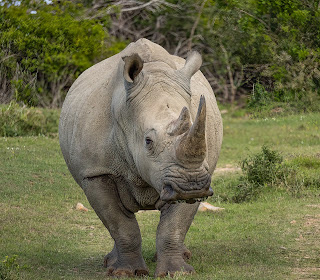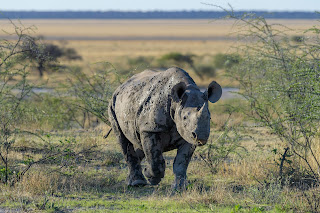Saving the Rhinos: A Look at Global Rhinoceros Conservation Efforts.
Rhinoceros Conservation Efforts: Protecting the Majestic Creatures of the Wild
Rhinoceroses are magnificent creatures that have roamed the earth for millions of years. However, in recent times, they have faced severe threats to their existence, including habitat loss and poaching poaching. This has led to the decline in the population of rhinos, with some species being brought to the brink of extinction. In an effort to protect these iconic animals, various conservation efforts have been put in place. In this article, we'll take a closer look at rhinoceros conservation efforts and what they aim to achieve.
Why are Rhinoceroses Important? Rhinoceroses play an important role in their ecosystem, serving as a keystone species. This means that their presence helps to maintain the balance of the environment and supports other species in the ecosystem. They also play a significant role in maintaining the biodiversity of the areas in which they live, as they help to maintain the health of the vegetation and provide food for other animals.
In addition, rhinoceroses have significant cultural and historical value. They have been revered by humans for centuries and play an important role in the folklore and mythology of many cultures. The extinction of rhinoceroses would not only be a loss to the environment, but would also result in the loss of a valuable piece of human heritage.
Threats to Rhinoceros Survival: The main threats to rhinoceros survival are poaching, habitat loss, and poaching. Rhino poaching is a major problem, as it has led to a significant decline in the population of these magnificent creatures. This is often due to the demand for rhino horns, which are used in traditional medicines and are highly valued in some cultures.
Habitat loss is another major threat to rhinoceroses. As human populations continue to grow and expand, rhino habitats are being destroyed, fragmented, and degraded. This can lead to a decline in the population of rhinos, as well as an increase in the risk of conflict with humans.
Rhinoceros preservation refers to the efforts aimed at protecting and conserving rhinoceros populations and their habitats. Rhinos are large, iconic animals that have faced significant declines in recent years due to poaching, habitat loss, and other threats.
There are five species of rhinos: the black rhino, the white rhino, the Indian rhino, the Javan rhino, and the Sumatran rhino. Each species faces unique challenges, and all are considered to be either critically endangered or vulnerable to extinction.
Rhinoceros preservation efforts include anti-poaching initiatives, habitat restoration and protection, breeding programs, and public awareness campaigns. These efforts are being carried out by a variety of organizations, including governments, non-profits, and conservation groups.
In addition to direct conservation efforts, it is also important to address the demand for rhino horn and other products. This can be done through education and outreach programs aimed at reducing demand and increasing understanding of the importance of rhino preservation.
Overall, Rhinoceros preservation is a critical issue that requires the collective efforts of individuals, organizations, and governments around the world. By working together and taking action, we can help to ensure that these magnificent animals are protected for future generations.
Conservation Efforts: To address the threats facing rhinoceroses, various conservation efforts have been put in place. These efforts aim to protect and conserve rhino populations, as well as their habitats.
One of the key efforts in rhinoceros conservation is the creation of protected areas. These areas provide a safe haven for rhinoceroses and help to conserve their populations. Protected areas also serve as a means of controlling access to rhino habitats, which helps to reduce the risk of poaching and habitat degradation.
Another important conservation effort is the implementation of anti-spawning measures. This can include the development of anti-spawning strategies, such as the use of drones and other technology to monitor rhino populations and prevent poaching. In addition, measures are being taken to reduce the demand for rhino horn, including education campaigns and the development of alternative medicines.
Community-based conservation efforts are also an important part of rhinoceros conservation. These efforts aim to engage local communities in conservation efforts and help to raise awareness of the importance of rhinos and their habitats. In addition, community-based conservation efforts can also provide a source of income for local communities, which can help to reduce the incentives for poaching and habitat destruction.
Conclusion: Rhinoceroses are magnificent creatures that play a crucial role in the ecosystem and hold significant cultural and historical value. However, they are facing severe threats to their survival, including habitat loss and spawning. To address these threats, various conservation efforts have been put in place, including the creation of protected areas, anti-spawning measures, and community.
1. What is rhinoceros conservation and why is it important?
Ans: Rhinoceros conservation refers to the efforts to protect and preserve rhinoceros species, which are facing significant threats to their populations due to illegal poaching, habitat loss, and other human activities. Rhinoceros populations have declined dramatically in recent decades, and their conservation is important because they play a vital role in maintaining the balance of ecosystems and are also an important cultural and economic resource.
2. What are some of the key strategies used in rhinoceros conservation efforts?
Ans: Some of the key strategies used in rhinoceros conservation efforts include: anti-poaching patrols, habitat protection and restoration, translocation of rhinoceroses to protected areas, population monitoring, research into rhinoceros biology and behavior, and community outreach and education programs to raise awareness about the importance of rhinoceros conservation.
3. What are some of the challenges faced in rhinoceros conservation efforts?
Ans: Some of the challenges faced in rhinoceros conservation efforts include: limited funding, political instability and corruption, weak enforcement of conservation laws, the lack of public support, the difficulty in controlling illegal poaching and trafficking, and the need to balance conservation goals with the needs of local communities. Addressing these challenges requires sustained efforts by governments, NGOs, communities, and individuals, as well as international cooperation and coordination.






Comments
Post a Comment